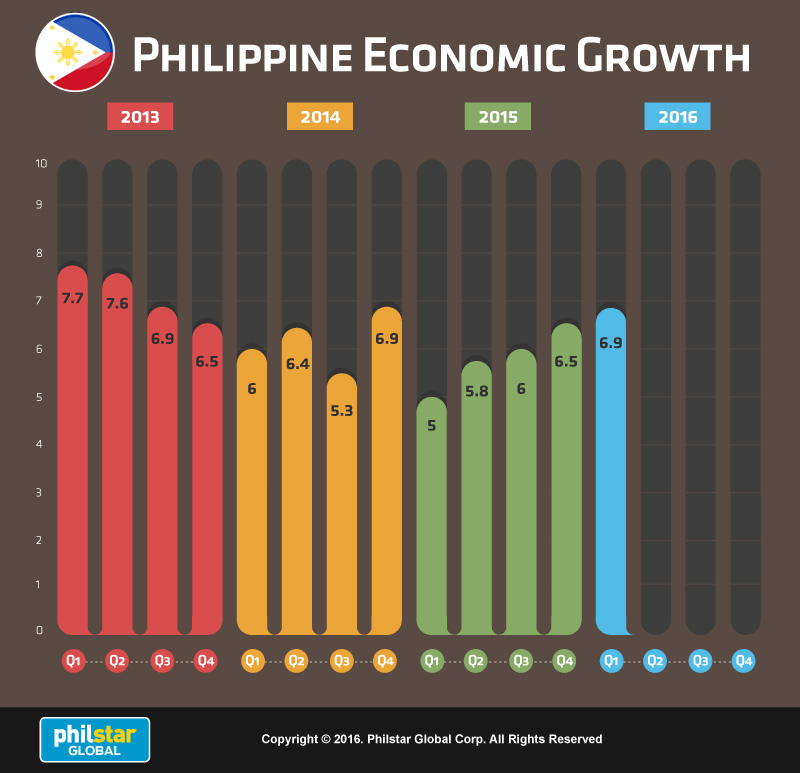Phl GDP hits 6.9% in Q1 2016, fastest among major Asian economies
MANILA, Philippines (UPDATE 3) — The domestic economy expanded by 6.9 percent during the first quarter of the year, the penultimate quarter under the Aquino administration, the Philippine Statistics Authority announced Thursday.
Socioeconomic Planning Secretary Emmanuel Esguerra said the Philippines is the fastest-growing economy among 11 selected Asian economies in the first quarter of the year, outpacing expansions in China (6.7 percent), Vietnam (5.5 percent), Indonesia (4.9) and Malaysia 4.2 percent).
"We are pleased to be turning over a strong and stable economy onto the next administration. We have achieved significant socioeconomic progress over the last five years with the return of political and economic stability, which we hope the incoming administration will build on," Esguerra said, referring to the incoming government of presumptive president Rodrigo Duterte.

The country's growth — based on gross domestic product (GDP) or the total value of all goods and services produced — was higher than the last quarter of 2015, when growth was recorded at a revised 6.5 percent. The agency said the revision was due to similar upward revisions in numbers in electricity; gas and water; public administration and defense; transport storage and communication; financial intermediation; and mining and quarrying.
Public construction bounces back, exports take a tumble
For the first quarter of the year, Esguerra said growth was investment-driven on the demand side, with significant contribution from investments in durable equipment.
"Fixed capital, which is a better indicator of investment growth, registered a 25.5 percent growth and contributed 5.8 percentage points to real GDP growth. Construction also grew faster at 12 percent during the period, compared with 7.6 percent in the last quarter of 2015 and 4.5 percent in the first quarter of 2015," he said.
In addition, public construction managed to reverse a 23-percent contraction last year to a 39.9-percent growth in January to March this year.
"All these investments give us confidence that the economy will continue to perform well in the succeeding quarters of the year and beyond," Esguerra said.
However, the National Economic and Development Authority director-general said that external demand weakened, with growth of exports decelerating to 6.6 percent. Imports stood at 15.9 percent due to purchases of capital goods, an indication that firms are investing.
Structural transformation
On the supply side, he said the economic growth was fairly broad-based.
"The high growth recorded for the first quarter of this year was driven by gains in the industry and services sectors. The industry sector recorded a growth of 8.7-percent, the highest in five consecutive quarters, supported by manufacturing, construction, and utilities," he said.
In addition, the services sector posted a 7.9-percent growth, on the back of faster growth in trade, finance, and real estate, renting and business activities.
"The strength of both the industry and services sectors once again shows the ongoing structural transformation taking place in our economy, which is crucial for sustaining economic growth and generating quality jobs," Esguerra said.
Agriculture still weak
Despite overall strong growth, however, the the agriculture sector remained weak, contracting by 4.4 percent from almost stagnation the past year.
"Admittedly, the sector remains vulnerable to extreme weather events. These past two quarters, it was the impact of El Niño that considerably reduced agricultural output, similar to the 1998 episode. But we have shown that this need not result in a spike in food prices with good management of the food stock," Esguerra said.
Moving forward, he said the government must increase public spending on infrastructure, specifically in the transport and logistics sector, given their immense role in the all sectors, especially agriculture.
"The development of a seamless multi-modal transport network as well as improving logistics such as storage and handling mechanisms will enable a more cost-efficient movement of goods and services across regions," he said.
Moreover, he said that investments in shared services and facilities, research and development and the use of modern technology will also be important in modernizing agricultural production and increasing resiliency to disasters. "With higher quality and volume and wider variety of agricultural products, the agricultural sector can gain access to larger markets locally and even abroad," he said.
On track to hitting target
The International Monetary Fund and the Asian Development Bank forecasted earlier this month that the Philippine economy would remain robust on the back of resilient domestic demand. The institutions pegged the GDP growth for the Philippines at 6 percent this year and 6.2 percent next year.
The growth would be faster than Indonesia’s 4.9 percent, Malaysia’s 4.4 percent, Thailand’s three percent, and Singapore’s 1.8 percent, the IMF said.
"Overall, the growth prospect of our economy for the next quarters is encouraging. Growth in the second quarter of an election year is usually stronger than in the first quarter. Barring a significant drop in business confidence in the second half, the economy seems to be on track in meeting the full-year target of 6.8 to 7.8 percent," Esguerra said.
- Latest
- Trending





























